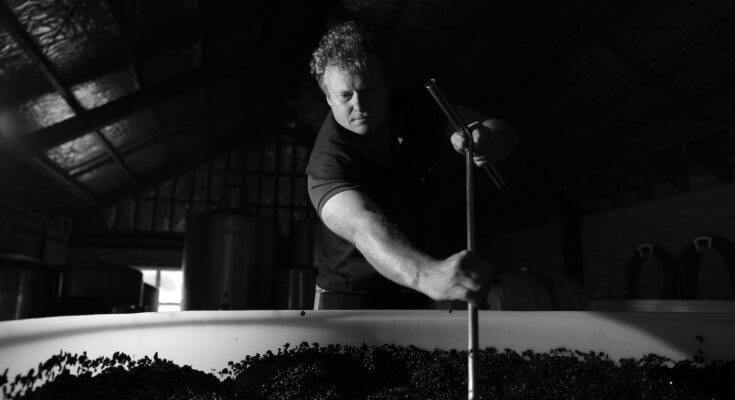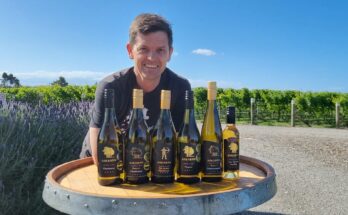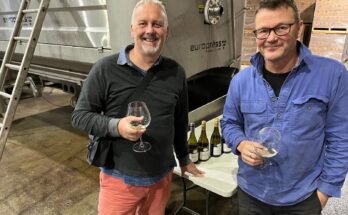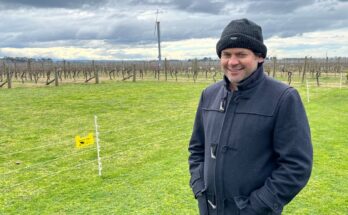After a flying visit back in 2021, I managed to sneak in an interview with Martin Bell, winemaker at Butterworth, at the winery on Te Muna Road, before harvest in February this year (and that huge deluge of rain).
WineFolio: How have you been through the last few months, because I have to say that for me, it has been hard! 100 days was a long time to be not able to travel outside of Auckland, and the absolute joy when we finally could – was amazing.
Martin Bell: A lot of places, even Wellington, still relied on that traffic, from Auckland coming through. The Government things, with people moving around, and, of course, that’s not happening. People aren’t going out to lunch any more, because you can’t entertain people. And then all of a sudden…
WF: But Kai Schubert was telling me he’s never been so busy?
MB: Absolutely 100%. Because every Wellingtonian has said “I’m sick of this – and I don’t want to fly anywhere – so I’m going to Martinborough, Gladstone and so on, and I’m going to spend up big here”. So it has been an interesting time for a winery perspective. Because Kai’s massively busy, but restaurants in Wellington are absolutely struggling.
So you tried the 2021 Riesling?
WF: Yes, that was good. Before we did the tasting, we all had a discussion about what we were likely to be looking at – given that I think we had one wine with under one gram of residual sugar, to one that was over eighty grams. So quite different styles. And I said that we needed to be very careful about how we look at the wines, and look for what was delicious in each one. It could be hard to fall into the trap of being seduced by sugar, because we humans love sweet things. And, almost, a really dry Riesling has to work a little harder to shine? Yours and the Maude did well, and both dry styles. I think the second and third place wines both had 31 grams of residual sugar.
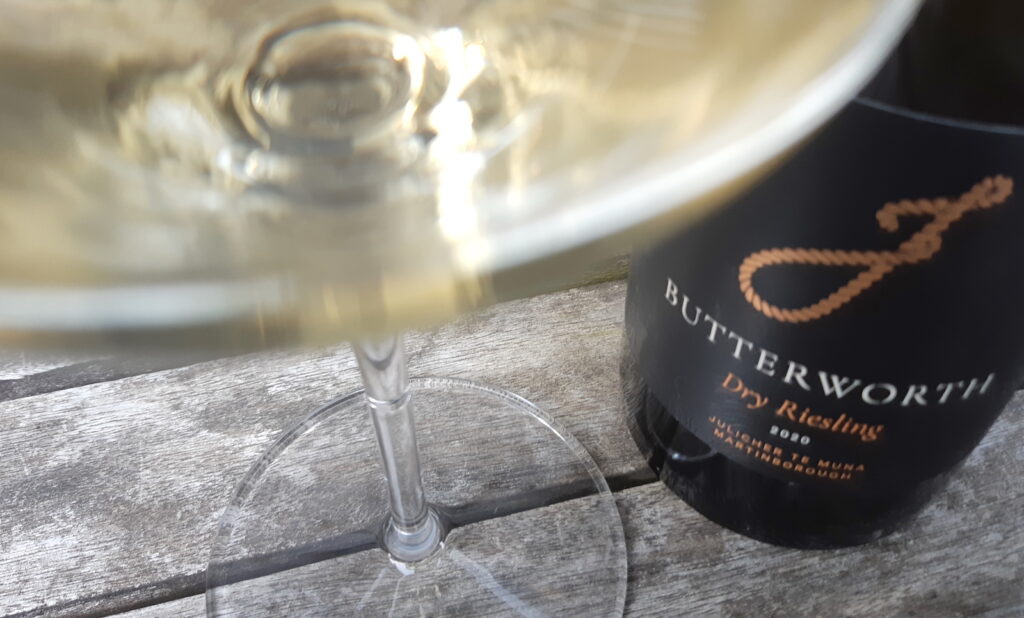
MB: Yes, the magic number.
WF: but a really good, dry Riesling is a magical thing too – a thing of beauty.
MB: It is. When I first arrived here they said ‘you’re making a dry riesling” and I thought “oooh, haven’t made one of those in a few years” It had been nearly ten years, so I had to re-acquaint myself with ‘drys’. And I didn’t go the Aussie dry way – I was looking at the Germanic dry… so Dr Loosen, for example. Those five to seven grams, with a searing acidity.
Towards the end of the ferment, it is tasting it three times daily. And there’s just that continuous “should I, shouldn’t I?” and then you just finally get to that point and go “that’s it”. And you smack it.
WF: Is that point obvious, once you reach it – or do you have to second guess yourself?
MB: Second, and third guessing! Sometimes it just happens. 2020 it happened with us – it was “Oh, there it is!” But in 2021, my harvest intern and I – we were eventually here at 9 o’clock one night, still tasting it. And we said to each other “I think this is it!” And we knocked it with a bit of sulphur. And this is the product – in your glass. We’re very very happy with it actually.
WF: Do you remember the first one I tried of yours – it would have been a Julicher 2018? It had a residue in the bottle and we had a conversation about it, but now I don’t recall what it was?
MB: Yes, it would have been the ’18 as we didn’t have a ’19 with that big frost. That was cream of tartar – wine diamonds. Being a small winery, we just don’t have the ability to get the small volume wines down to minus four. I cooled it, and had it outside over the winter period. I remember doing it as a kid, with a paperclip on a string in a really salty solution, and the crystals used to build on there, and it is weird that in winemaking you actually apply that science.
WF: That is a really delicious Riesling. The thing with the Top Tastings is that it is not just me, and my opinion. I think I liked it more than most, and maybe it got one ‘it’s Ok’ vote. All it takes is for one person to be cool on it and it drops out the Top 10 completely. I’m pleased we managed to do it, even with COVID around. Some people were a bit reticent.
MB: I think the thing with Omicron is there’s just so much uncertainty out there of everything really. You’ll be having orders – for example, one from Ireland which was really big – and literally, Omicron hit them… and they halved it. That’s the joy of Omicron for the industry – you’re just juggling orders until the time it goes on the boat.
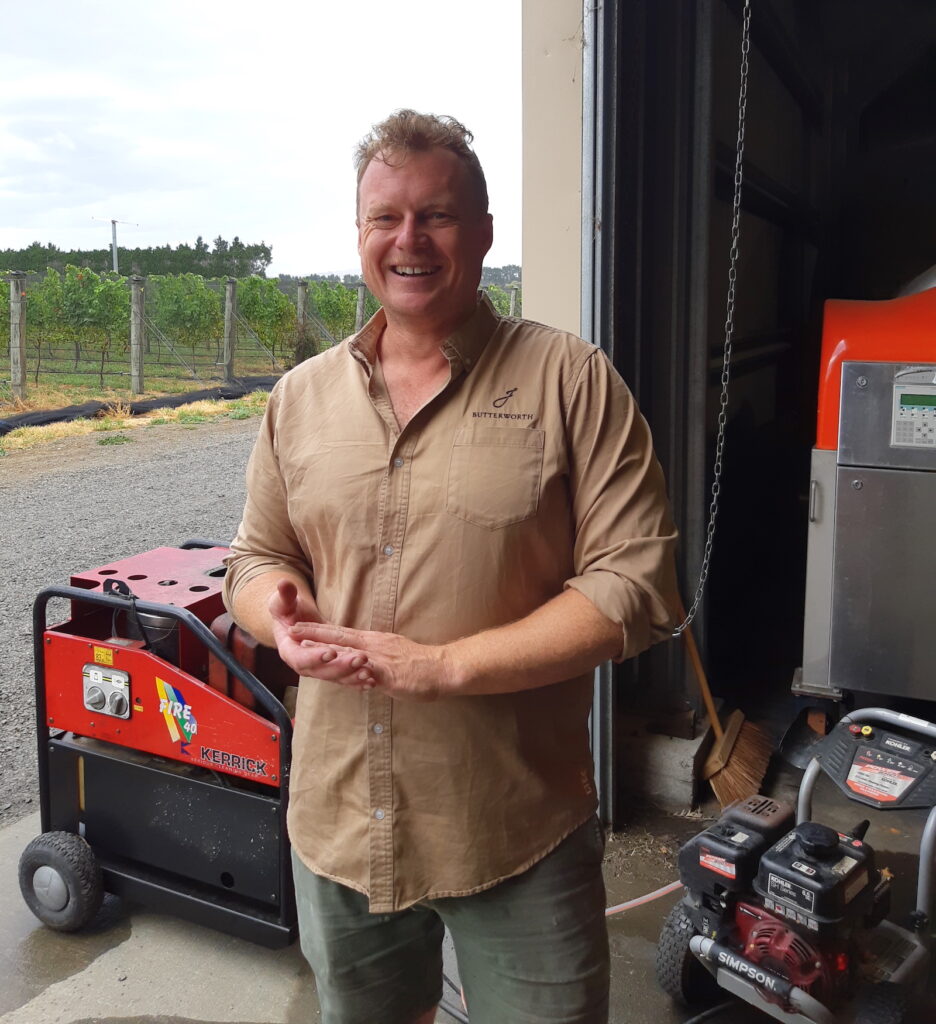
WF: Imagine getting it just as harvest arrives?
MB: It would be diabolical. I’m basically a one man band with an assistant, really. Without the winemaker it’s pretty hard to make wine, I think. Everyone could sit there and YouTube it?
WF: Funny enough, for the Riesling Top 10 tasting we had a really wide range of styles – including one Pét Nat, from Greystone. It was Riesling, so we tasted it!
MB: It is a good style, and I applaud those that can make good ones, you know.
WF: So, ageability for that – over ten years?
MB: Oh Jeez, easily. Very low bot, so it’s going to hold that freshness. That ’18 had a bit of bot in it, and that’s starting to show now, with a little age character, even after four years. The ’20 and the ’21 were very free from bot and because of that those clean flavours are just going to keep that smooth gradient up for ageability. I do like the ones with a bit of bot in as well though. They look wonderful around 15 years – they get that wonderful burnt apricot jam flavour. This was picked nearly in April, and its still only 11.5% alcohol – so just that hang time. I think that’s maybe the key factor for us at Te Muna. It’s slightly cooler at night, but warmer during the day. I’m hoping to put a bit more Riesling in. And a few different clones – this is all 110, just to give it a bit more. I love this wine, and I want this wine to grow!
So, next – Sav Blanc – this is our new release. It hasn’t been released yet, actually. Barrel-aged Sauvignon 2020, bottled just before Christmas. We’ll look to release this in the next month or so. We put it into the NZIWS, just to see how it does?
WF: Having worked the New Zealand shows, it interesting to see how some of the more generic wines can shine, and sometimes the ones with personality don’t make the podium. I’m always quite keen, open-minded, and positive when I’m looking at wine.
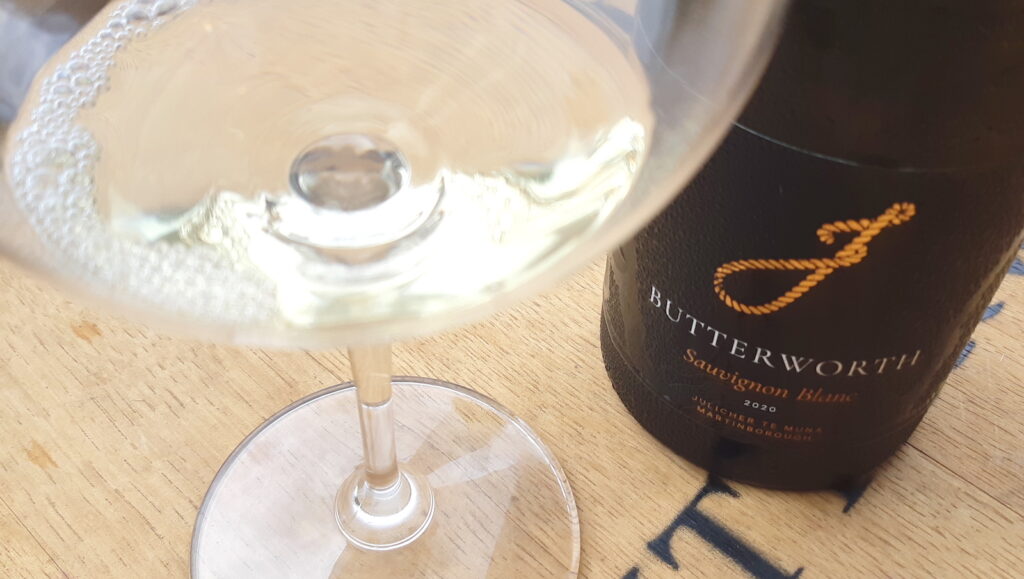
MB: Positive judging. When I was doing judging, it is how I was taught to do it. Everything is a gold until they prove otherwise. The positives and negatives of every single one of them. Like with the Riesling. Ours and Maude as dry Rieslings against ones with 30 grams of sugar – it shows fair judging. Judging a wine for what it is, and the style it is. Looking at every wine as a positive.
WF: So the WineFolio rule no.1 is ‘delicious’. Is this wine delicious? Because that’s what we’re looking for.
Anyway – tell me about this wine, because it is delicious!
MB: It got 16 months on lees, full gross lees. 12 months in barrel, all old oak. It is fermented in oak, and this particular year it wasn’t unfortunately hand-harvested. It was 2020, and we had six pickers – who did an awesome job and picked fifty-odd tonnes, and they got to the Sauvignon, and you could just see their heads drop. Because there’s fifty odd rows of Sauvignon. We got our friends down the road at Craggy Range to take it off with a harvester, and that’s the first time we’ve ever had to do that. But there was no way with six pickers that we were going to get it done. The fruit was still in beautiful condition. That little bit of maceration has helped it a little bit.
WF: This has a lovely golden, crushed tarragon green herb flavour – ripe and direct. Nice texture, good line of acidity. That white Bordeaux, style but with a distinctive Te Muna acidity.
MB: This in about a years time with a lovely piece of salmon, or any kind of seafood, it’s going to taste amazing. That ripeness from the hang time. I think you’ve tried our ’18 Pinot – but shall we have another try of it now?
WF: Sure, always happy to see how things have developed. I love the colour of that – really glowing but quite pale ruby. I’m amazed at the range of colour in New Zealand Pinots now. You wouldn’t believe the ding dong we had at our place last night – about three hours of discussion about what ‘Pinot is supposed to be like’. I was saying “I don’t care what the colour is like – taste it”. For me, with Pinot, it’s about that initial perfume. I could just smell that, all day.
MB: This is four years on, and you can just see it starting to hit its straps now. It’s important for the Butterworths that we make enough of this that we’re always four years behind. I’m totally behind that. I think that having a Pinot up, at ’20 or ’21 release is lovely, but having the ability to show people – especially at this price – something that has got a little bit of age. You can see where it is starting to head to. To show a consumer this at 4 years and say “imagine this in 10 years..” I think that is where New Zealand Pinot should be at. It’s fun.
WF: But as well as that serious but ethereal nature to it – this has a real pop of juicy flavour to it as well.
MB (smiles) That’s Te Muna. 100%. In 2020 I had a guy from Bordeaux who came and did ferment rounds with me, and he said “I didn’t realise Pinot had fruit? This is more fruit than I get in Bordeaux. We don’t get this fruit weight and power.” It is something I try to promote, is that fruit weight. The ferments never get more than 31 degrees, one plunge per day, twenty days on skins – is about the usual. But, that is totally dependent on what’s happening. Last year was probably an average of 17 or 18 days because we had a lot of shot berry – the very small berries – and so the extraction was just that much faster. But 2020 was about 22 days.
All pressed off by taste – as soon as you start to get that little bit of bitterness in the back palate – straight to the press. And that’s the joy of being a small winery, is that we can react that fast. Things are changing so quickly.
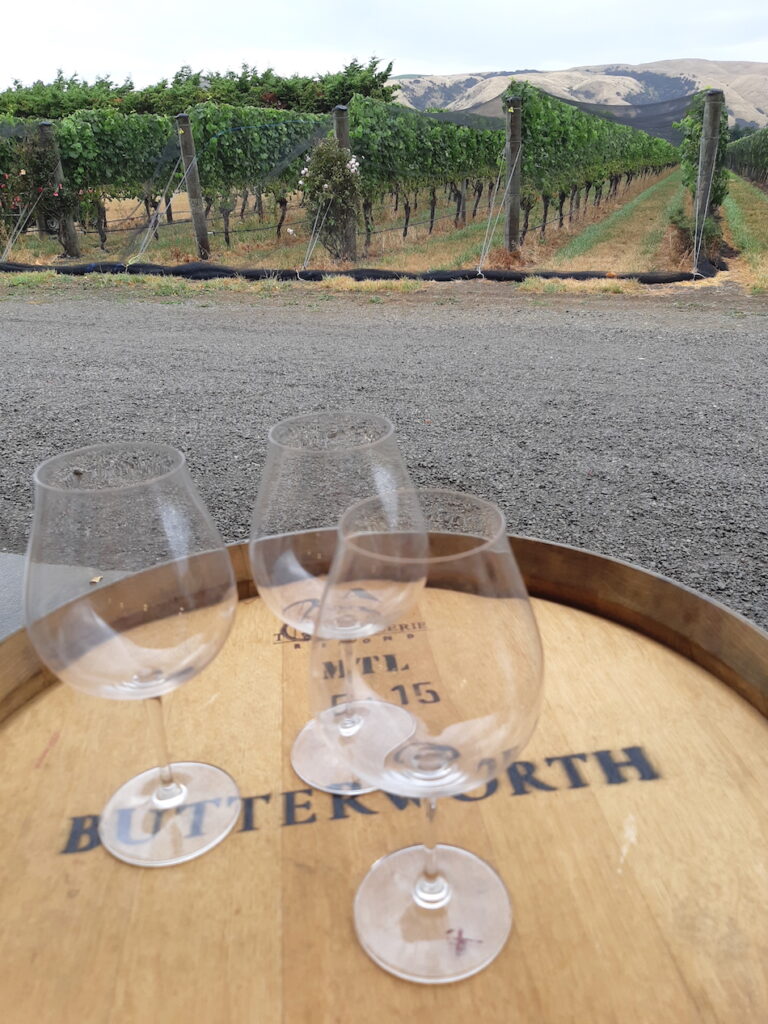
WF: This wine is really putting a smile on my face. It has so much going on. I adore the tannin in this. I have a sip and I think, ‘no, the tannin is just one part of it’ – but it is a part I keep coming back to!
MB: when the Julichers employed me they said to me that the Julicher Estate was always going to be a ‘single vineyard wine by design’. You actually build a Pinot from this. I thought ‘What on earth are they talking about?’ because I came from a place where you made wine from this block, and then wine from this block. Well then when I was tasting through – and every single block, and every barrel was different; and I thought ‘I can do this’. You get the tension in there, the crunchiness, the floral prettiness.
There was one barrel, I swear to you – it tasted like a Gewurz! It was all rose petal and all up on the top end, and no weight down the bottom. And I thought “you are going into this – this is going to be amazing!”
And there was this one block – 115 – out the back with weight and heaviness and density and it was like a Pinot for Merlot lovers. I couldn’t believe it. I wanted more of it! So I was able to build this Pinot up and around, with this tension. So this actually is a single vineyard wine by design. And again, the joy of Te Muna Road – the acids hold. I brought my Abel in, and it was beautiful and ripe – the flavour were perfect – sugars were on the money, and it came in with a pH of 3.3. So after malolactic I think it was at 3.45, so that’s your strength in the middle of the palate. And that’s where Martinborough, with the Abel clone is special, it just has this acidity.
WF: What’s the main clone in Marlborough? Is it 10/5?
MB: I think Central is more 10/5. At Giesen we had Clone 5 and 6 and a little bit of Abel too – that was wonderful, but then we had all the Dijons running through, like a patchwork. Every ten rows there’s something different.
WF: I often hear that 10/5 is regarded as a bit of a workhorse – that it’s nothing special, but I recall at Bell Hill, they were looking at it as though it might become a single clone wine for them, there.
MB: Malcolm Rees-Francis was the same. He was always talking about his 10/5. We’ve got a new plot we’re planting just next door, and we’ve got some 10/5 going in there.
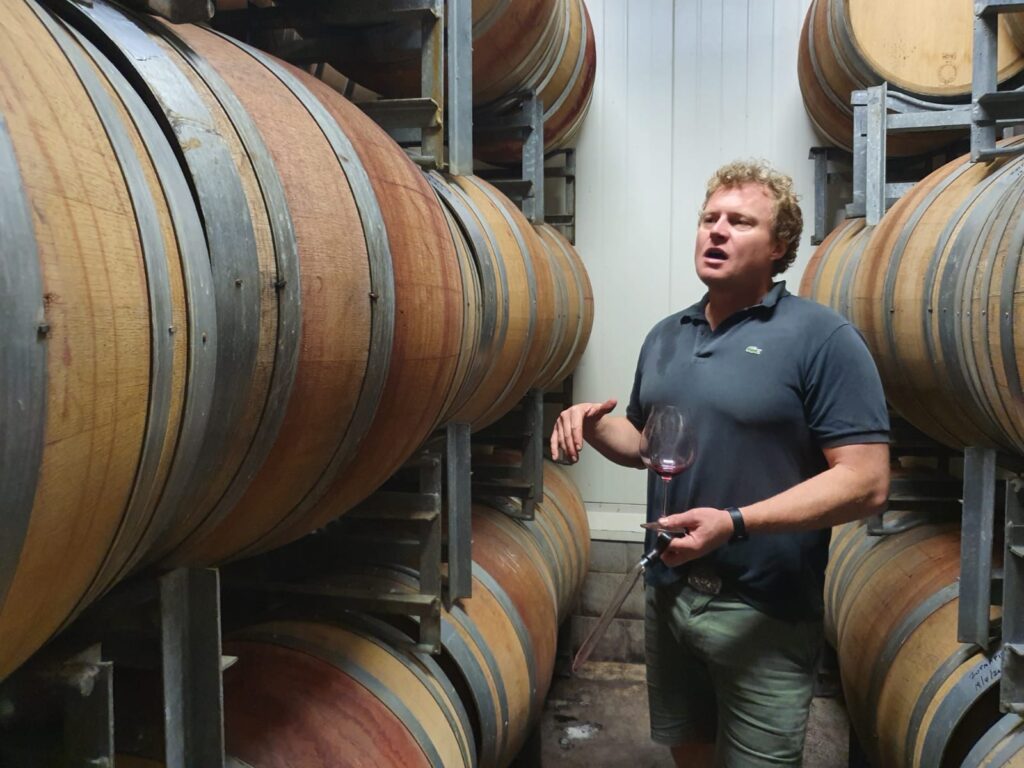
WF: How are your new plantings going – they look good to me? Chardonnay wasn’t it?
MB: Yes, fabulous. Planted in October. That’s all Chardonnay. We’ve got 15 and 95 here in our Chardonnay and some Mendoza down the back there. That might even crop next year. And we’ve replanted a bit of old Pinot that had been grafted on to Sauvignon vines, with 548 Chardonnay and that’s going to be our workhorse. And thirty rows of 95, and ten rows of 1066. You’ll have heard about winemakers raving about Mendoza – Helen just loves it – well 1066 is like Mendoza on steroids – especially when it comes to hen and chicken. A little bit higher in alcohol, but holding that beautiful acid line through it.
WF: Is that that Muscat one?
MB: No, no, that’s 848 or something like that. I got offered a bit of that. I think Palliser are making a wine out of that now. The 1066 – Riversun were like ‘don’t do it’. Winemakers love it but grape growers hate it. So I’m like “You know what – I’m a winemaker, and I’m the one who’s choosing!” What I’m hoping is that, because it is so up and down in crop, is to get a puncheon of that per year. Ten rows, about 850 kilos, and then that is going to go towards an icon wine.
WF: Oh, wonderful. Well, I heard about it first, so let me have a taste of that when it’s ready!
MB: And we’re also producing an icon Pinot as well. Whereas the Pinot in your glass is made as this ‘whole’ kind of thing, ‘The Tactician’ is going to be weight. That 115 and Abel. The inspiration behind it was that Brad and Warren, the two owners, they love to have a wee cheeky cigar, but they want to drink their wine with their cigars. And Pinot is lovely with cigars – don’t get me wrong. So this is a Pinot for cigar smokers. 1000 bottles, couple of magnums, etched bottles, corks, wax seal. Just waiting for the bottles from France. They were supposed to come in December. It is the 2020 vintage though, so we’ll be patient.
WF: Remind me what you were doing at Giesen before this?
MB: I was in the Premium section, so I was playing with Clayvin and Ridge and Waihopai block. But also a little bit in product development as well. I was working on the whole low alcohol thing, which was a great time. It has been a great journey. And then this job popped up, and there’s no way I’m turning down Te Muna Road, it is too good a chance. It has been a fun ride and loved my time at those places, but this is something special.
And I’m across everything. Digging holes, filling out paperwork. Cruising the vines and talking to the Vineyard Manager about what is going on, and then out in the sales and everything. You run around and you burn the soles of your feet! (laughs). One thing that is happening though is a bit more young blood coming through. The old crew are still here. You’ve still got Larry and Helen and Strat Canning, but there’s these young bloods rising underneath, and bringing with them a lot of cool ideas.
WF: I think you can include yourself in that.
MB: I think I can. It’s nice too because you’re accepted. The older guys are actually very very cool. They listen to you when you talk, and there’s a lot of interaction.
WF: I think it is a sweet spot at the moment. You’ve got our market age, where we’re beyond that initial foray, and now into ‘well now we know we can do it… so what should we actually do?’ Plus vine age. Plus the age of those pioneers, and looking to help up those who will follow them.
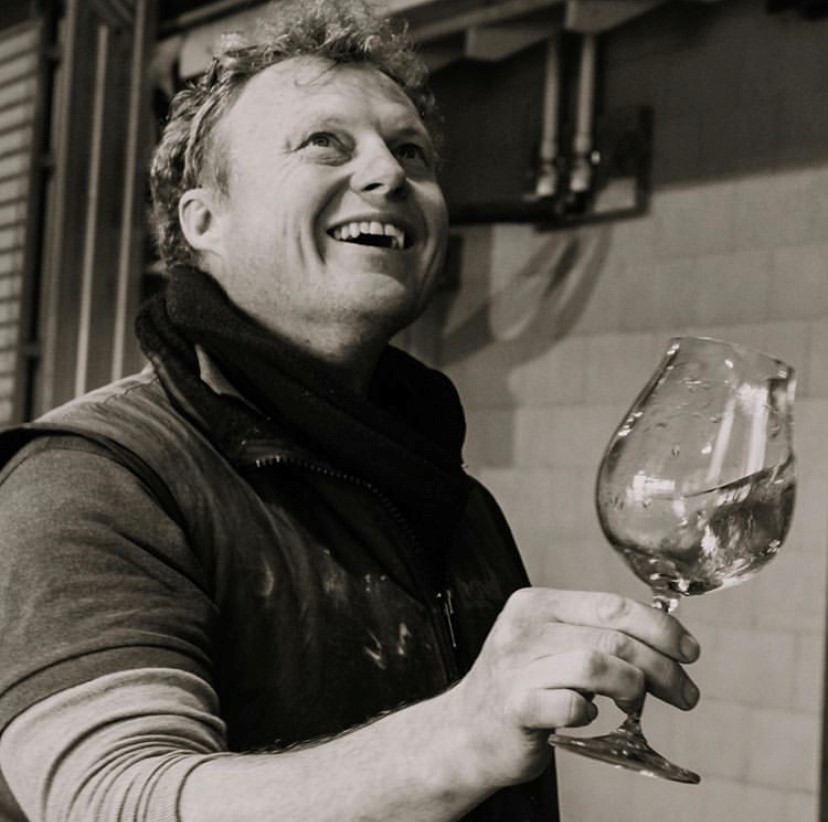
When I spoke to Huw at Pyramid Valley, he was talking about the understanding of the place and how that plays a big part too. Taking that legacy on. He was a very smart guy.
MB: We’re looking at bigger format oak and cuves now. The winery here has been put on a back burner, because all the money has gone into the vines. When I first got here, the Chardonnay would be lucky to get to the top wire, and you wouldn’t have to trim the Back Block because it was never up there. It was real struggle street. Water shortages, and wind, very bony soil. Now, we’re not just putting seaweed on the soil, it’s essentially an organic pro-biotic that is going into the soil to try and build that biomass up in the soils. Water retention and nutrition is better now. Now the vines are growing better and a healthy vine means healthy wine. And any disease pressure – it will handle it better.
We still get those massive frosts. We’ve just installed another frost fan in the middle, and we’re going to have another two parked up into there. Those frosts are getting more and more severe. This year wasn’t so bad – we only had eight or nine of them, but last year we had eighteen! And ten of those were under minus two degrees. With climate change we’re not necessarily getting hotter or colder, we’re getting more extremes. When Wim first started out he might get two or three frosts a year. Now we’re looking at eighteen, and they can happen up to harvest.
WF: How’s the re-brand over to Butterworth gone?
MB: it’s gone really well. I think holding a legacy has been really good. The gold J has really helped. Having Wim’s name on the bottle gives that tie-in, and also on the back – ‘founder Wim Julicher’. It has shown that it is not just a new brand. Both Brand and Warren are really big on family and lineage. And Wim is still as much a part of this place now as he was back then. He was in last harvest and he was on the tractor – tipping fruit and having a rare old time. That tractor is still going – a 1953 International.
The new name is easier to pronounce, and recognisable. We’re doing super well in the States, around all the yacht clubs – they all know the Butterworths. They were very insistent though that the product inside has to remain the same. Same philosophies that Wim brought in – no fining agents, vegan-friendly.
WF: I’m seeing little improvements though!?
MB: Oh yeah, we’re always thinking how can we improve – in the vineyards, in the winery. The incremental changes that we think will improve the wine, but still hold that style. And I’ve still got to work with the terroir. The most important thing is the land, and what the grapes produce from that. I just guide it.
WF: what is the best part of a winemaker’s year, for you?
MB: The celebration is Vintage. Bringing that fruit in, is a celebration. We really saw that last year when Brad and Warren were here. You saw the joy on their faces – a grin never left them. That day was a joy. We had a long table, with a big spread in the middle of it. We were picking the 115 and the Chardonnay that day, and all the fruit was just immaculate. There was talking, wine flowing. It was one of those days.
The joy of joys is Vintage – but… I’m a winemaker! Even when you’re dealing with waste water – you think “I’d still rather this than being in an office”. There’s so much satisfaction in this job, I enjoy every moment of it.

